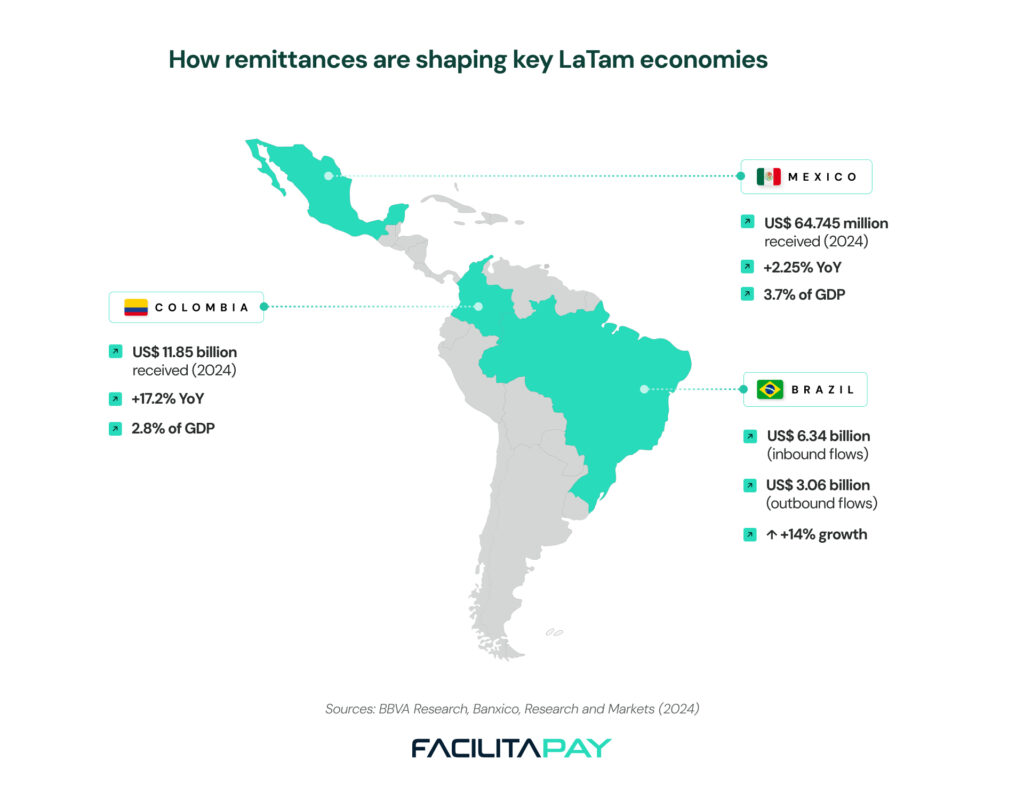Remittances, or international money transfers, are more than just economic transactions, they are the financial backbone of millions of households and an essential engine of regional economies. In Latin America and the Caribbean, this flow of capital has become increasingly relevant, not only for supporting families but also as a strategic tool for global companies seeking to scale operations across emerging markets.
Recent data reveals the true scale of this transformation: in 2024, remittance flows to the region reached $160.9 billion (BBVA Research), a $7.7 billion increase compared to 2023. In countries like Mexico, Brazil, and Colombia, remittances are not only growing in volume, but also playing a critical role in shaping the financial infrastructure that global companies must engage with to succeed locally.
The current remittance landscape in Latin America
Latin America is now one of the top regions globally in terms of remittance inflows. These transfers are often used to cover basic expenses such as housing, food, education, and healthcare, but they also fuel consumption, increase liquidity, and influence local financial behaviors.
For companies that operate across borders, including marketplaces, fintechs, gig platforms, investment apps, and B2B SaaS, understanding and integrating with this remittance ecosystem is key to unlocking new revenue, improving margins, and ensuring operational scalability.
Highlights across the region:
- Mexico received US$ 64.75 million in remittances in 2024, representing a 2.25% increase over the previous year (BBVA Research, Banxico).
- Colombia received US$ 11.85 billion in remittances in 2024, reaching 2.8% of GDP, with a +17,2% increase compared to 2023 (Banco de La Republica)
- Brazil recorded US$6.34 billion in inbound flows in early 2024 (+14.1%) and $3.06 billion in outbound flows (+18.5%) (Research and Markets).
These numbers are not just macroeconomic indicators, they directly impact how your company can collect, pay, convert, and move capital efficiently within the region.
Challenges and opportunities in the Latin American market
If your company is expanding into Latin America, there’s no way around it: you’ll be dealing with local currencies, financial regulations, user preferences, and all the nuances that come with them.
Key challenges include:
- Regulatory complexity: AML (Anti-Money Laundering), KYC (Know Your Customer), and local licensing requirements vary widely by country and can delay time-to-market;
- Currency volatility: Hedging strategies and transparent FX processes are essential to protect your margins and ensure predictable payment cycles;
- Infrastructure disparities: Many regions still face limited banking penetration, requiring alternative payout methods that are both compliant and accessible.
That said, the opportunity is clear: companies that master these elements can create a competitive advantage, while offering superior experience to customers, partners, and vendors in Latin America.

How global companies can thrive in Latin America’s remittance economy
To fully capture this market, it’s not enough to just plug in an API. You need a full-stack approach, local payment rails, regulatory expertise, and user-friendly infrastructure that’s already been tested in-market.
Here are five proven strategies:
- Automate and integrate payments Embed international payment flows into your ERP or CRM systems to streamline operations, reduce errors, and ensure scalable performance;
- Partner with local fintechs: Collaborations with established players like FacilitaPay enable faster go-to-market, lower transaction costs, and built-in compliance;
- Adopt digital wallets: Local wallets integrated with systems like Pix (Brazil) or SPEI (Mexico) deliver the speed and flexibility that consumers and suppliers expect;
- Prioritize compliance: Aligning with specialists ensures your remittance flows are safe, auditable, and fully aligned with central bank regulations;
- Elevate the user experience: Companies that offer localized, intuitive payment experiences see higher retention and stronger brand trust;
A region on the move
Latin America’s remittance market is not just growing, it’s becoming more sophisticated, digital, and strategic. For international companies, this is a defining moment: either you adapt to the way money moves here, or you risk being left behind.
The good news? You don’t have to navigate it alone.
FacilitaPay supports some of the world’s leading companies with localized payment infrastructure, compliance-as-a-service, and seamless integration to Latin American ecosystems, from onboarding and FX to payouts and collections.
Ready to build a smarter, more connected operation in Latin America? Talk to our specialists and turn remittances into a competitive advantage.








